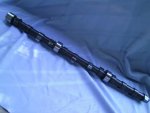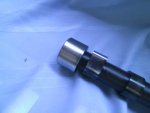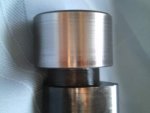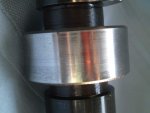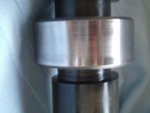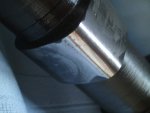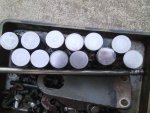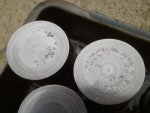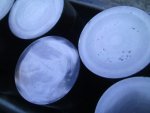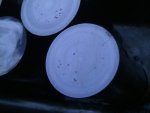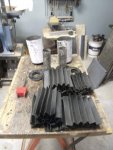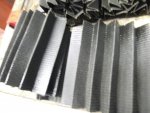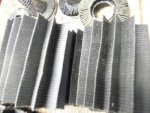Using a wrench, I spun the engine to make sure that the engine was free and the gears meshed and turned correctly and found no problem.
I did find that I could rock the cam gear quite a bit. I removed the retaining bolts from the front of the cam and removed the gear and front portion (i.e., the broken piece) of the camshaft.
The cam shaft had broken immediately behind the first bearing. I found no evidence galling, excessive heat, or oil starvation on the bearing journal of the camshaft, and none on the camshaft bearing. Both are worn smoothly and the broken bit of the cam shat spins freely in its bearing.
Also see post #24 of this thread.
I have gotten the feeling that some readers have either misunderstood what I meant by "rock the cam gear" or do not fully appreaciate the impact that .009” clearance between the cam journal and the cam bearing had.
Since I made that post I have tried to come up with a way that would illustrate what I was trying to describe and also show just how badly the front cam bearing in this engine is worn. So I reinstalled the broke bit of cam and the cam gear back into the block. I was careful to set the thrust and torqued the plate down carefully to spec. Then I made a movie.
I have never made a movie before, therefore, using this descriptive tool did not occur to me until recently. I wasn't quite sure just what was going to come out of the camera; I also have NO idea how to edit these things, so I will appreciate your indulgence and patience when viewing this vid.
https://www.youtube.com/watch?v=R3yVg-ecY4g&feature=youtu.be
Some have speculated that we might not find the direct cause of what broke this cam shaft. Others seem to feel that a manufacturer's defect or design flaw was responsible for the failure. They are certainly welcome to their opinions, but I think this video clearly shows the stresses that the camshaft had to withstand.
I feel fairly comfortable stating that this camshaft broke due to worn camshaft bearings. I don't think I'm overstating my case when I say, "the cam broke where it was going to break", i.e., its weakest spot.
Further, I feel that I have seen enough of this engine to SPECULATE that the lack of oil pressure on start up especially due to the design of the cam drive caused the bearings to wear long before they should have. To this point, the camshaft bearings are the only component in this engine I have found worn beyond the wear limit spec.
Have all of the camshaft failures in the LDT465 occured due to worn cam bears caused by dry start up? I don't know. I have only examined THIS engine. But I DO know that ALL LDT465 engines take 8 +/- seconds to build up oil pressure.
This being said, it might be wise to start looking into developing a pre-luber for your multi-fuel engine. Based on what I have seen in this engine, I know building one has moved to the top of my list of projects for my own truck. A person with the money and other resources might think about producing a kit ... Just please don't have the thing gold-plated.
Going forward I do intend removing the rest of the cam bearings. I do intend dropping the oil pan and pulling a couple main and rod caps to see what might be seen.
More pictures will follow.
Finally, at this point, l am of the opinion that this engine could have had its camshaft, bearings, the bent push rods and bent valves replaced and put back into service. Of course, I am reserving the right to change my mind based on what I find when I drop the pan and etc.


